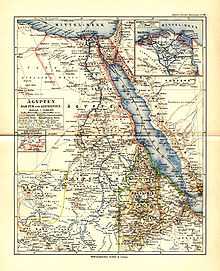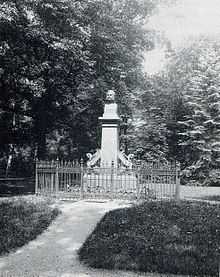Hermann Steudner


Carl Theodor Hermann Steudner (1 September 1832 - 10 April 1863) was a botanist and an explorer of Africa.
Education and early work
Steudner was born in Greiffenberg, located in Silesia, but grew up in Görlitz. He studied in Berlin and Würzburg botany, mineralogy and medicine. Among his professors were Christian Gottfried Ehrenberg, Heinrich Wilhelm Dove and Carl Ritter in Berlin, respectively Rudolf Virchow, Franz von Rinecker and Albert von Kölliker in Würzburg,[1] where he made friendship with Ernst Haeckel.[2]
Returned to Berlin, Steudner devoted himself to botany and published on Marantaceae. He was elected member of the Berlin Society of Friends of Natural Science. Heinrich Barth of the Gesellschaft für Erdkunde zu Berlin convinced him to participate in an Africa expedition to search for Eduard Vogel, whose traces were lost in the Ouaddai Empire.[3] This expedition was initiated by Ernest II, Duke of Saxe-Coburg and Gotha.
Expedition to Africa
The expedition was led by Theodor von Heuglin and started on 4 March 1861 in Alexandria. After shipping over the Red Sea they landed at Massawa on 17 June 1861 and observed birds on Dahlak Archipelago. Their way through the Ethiopian Highlands led them to Keren in the country of the Bilen people, from where Werner Munzinger came to join them, and afterwards to Adwa, where they met Wilhelm Schimper. Here the expedition split in two parties. Steudner remained at Heuglin. They made a wide detour through the Galla country in order to search for Tewodros II of Ethiopia. After visiting Gondar and Magdala they came to Edschebet, where they were guests of Tewodros. From Lake Tana they turned north. Over the Blue Nile they reached Khartoum in July 1862.[4]
Because of this detour, the leadership of the expedition was taken from Heuglin. They used the break to visit Kurdufan, where they followed the traces of Theodor Kotschy. On 25 January 1863 they joined Alexandrine Tinné on her tour up the White Nile to the Bahr el Ghasal. Steudner died of fever on 10 April 1863 in Waw near the Jur River.
Honors
| Wikimedia Commons has media related to Araceae. |
Steudner visited regions which were never explored by a botanist before. Hence, his careful reports were of high importance. Renowned herbariums as Kew Royal Botanic Gardens London, Natural History Museum London, Muséum national d'Histoire naturelle Paris, Swedish Museum of Natural History Stockholm, and South African National Biodiversity Institute National Herbarium Pretoria keep findings of him. The Algerian Sand Gecko (Tropiocolotes steudneri) is named after Steudner and a friend, Karl Koch, gave a genus of Aroideae, a sub-family of Araceae, his name as well (Steudnera). In Görlitz, a monument was erected, but it was largely destroyed in World War II to use the metal for military purposes.
References
- ↑ Lexicon of Upper Lusatian Science Society
- ↑ Ernst Haeckel. Entwicklungsgeschichte einer Jugend, Briefe an die Eltern 1852/1856. Leipzig, KF. Köhler, 1921
- ↑ Schindler. Nekrolog. Vorgetragen zur Hauptversammlung im October 1863. in: Abhandlungen der Naturforschenden Gesellschaft zu Görlitz, Vol. 12, pp. 201-205, 1865
- ↑ Hermann Steudner. Travel reports in Zeitschrift der Berliner Gesellschaft für Erdkunde und Zeitschrift für allgemeine Erdkunde 1861-1864.
Further reading
- Friedrich Ratzel (1893), "Steudner, Hermann", Allgemeine Deutsche Biographie (ADB) (in German) 36, Leipzig: Duncker & Humblot, pp. 155–156
- Meyers Konversationslexikon, 1885-1892, Vol. 15, p. 309
- James Quirin. "Caste and Class in Historical North-West Ethiopia: The Beta Israel (Falasha) and Kemant, Journal of African History, Vol. 39, 1998, pp. 195–220
- Georg Schweinfurth. Beitrag zur Flora Aethiopiens. G. Reimer Berlin, 1867 online
- Annelore Rieke-Müller. Der Blick über das ganze Erdenrund - Deutsche Forschungsreisen und Forschungsreisende im 19. Jahrhundert bis zur Deutschen Afrika-Expedition 1860-1863. WILEY-VCH Verlag GmbH & Co. KGaA, Weinheim, 1999
External links
|